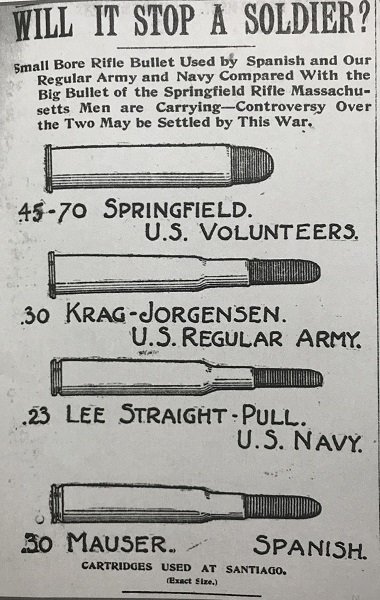

General:
The weapons used by the various army regiments and the U.S. Marine Corps represented variations in the evolution of firearms. Not everyone agreed that it was a good idea to make the leap from the 45-70 "Trapdoor" single shot rifle to the Krag Jorgensen rifle or the Lee-Metford rifle with their multi-shot magazines. for a variety of reasons.
First, some believed that the smaller calibers of the Mauser,
Lee and Krag
were a mistake since they did not have the "take down" power of the
large caliber 45-70 "Trapdoor."
They argued that, even though the smaller caliber weapons would wound
and eventually kill the enemy, the goal was to stop their attack
immediately and believed that the larger caliber weapons could do this
more reliably.
Some advocates believed that using a magazine weapon was a mistake as soldiers would waste ammunition by not taking the time to aim properly, something that a single shot weapon would force them to do. The "useless" expenditure of ammunition would raise the war cost, and would create logistical issues if the soldiers expended the ammunition faster than it could be supplied. Conversely, it was argued that the smaller caliber ammunition weighed less, and therefore a soldier could carry more of it.
The smaller caliber weapons also used smokeless powder. Not only did the lack of smoke help conceal the soldier's firing location, the smokeless powder allowed for higher muzzle velocity. This allowed for a flatter trajectory of flight of the bullet, meaning less correction was necessary when firing, and the soldiers could get a better aim. However, it was argued that the velocity was too great and the round would pass through the enemy's body without causing serious damage (i.e., it would pass through a bone creating a small hole rather than breaking the bone and stopping the individual).
Initially, it was claimed that the Spanish were using explosive
ammunition. However, it was later discovered that the Mauser,
Krag and Lee
rounds had a tendencey to wobble at shorter ranges, meaning that when
the bullet hit, it did not necessarily hit point first. When it hit at
an angle at high velocity (called "keyholing"), it had an inadvertent
explosive effect, creating far more injury. At longer ranges, this
effect did not occur. This must be remembered when reading some of the
accounts below.
The accounts below reflect the findings and conclusions of the men in
the field who witnessed the effects of the gunfire from these various
weapons.

Pvt. Charles Johnson Post, 71st New York Volunteer Infantry:
"...It
was our army's first experience with the high velocity Mauser
bullets that burned like a cautery as they went through and
left but a tiny puncture.
Assistant Surgeon Joseph B. Green of the U.S. Revenue Cutter HUGH McCULLOCH:
"...There were many cases of gunshot wounds from Mauser bullets that healed promptly without the least surgical interference. One case, I remember, was a Filipino soldier who was shot through the right lung, and returned for duty in the field at the end of three weeks. Another patient had a perforating wound of the right lobe of the liver, and was never sick enough to remain in bed. I have notes on only two cases where crushing of the bone was produced. Frequently there were clean holes through the long bones...The cases of gunshot wounds observed proved that the small rifle ball of high velocity is much less deadly than we were led to believe from experimental researches made prior to the war by the Medical Corps of the Army. It is certainly a humane bullet, for the fatal cases usually die on the field, and the majority of the wounded have an early and satisfactory recovery without loss of limb. .
Capt. H. Eugene Stafford, 71st New York Volunteer Infantry:
"From my experience wuth the Spaniards
whom I attended, I
found that the Krag-Jorgensen ball had a similar effect to the Mauser. It
is a little larger calibre; that was about the only difference..."
From the Clay Butler Letter
which mentions the "HARVARD Incident"
"...The worst thing was the fight on board. Monday night about 12 o’clock we were aroused by the noise of guns and the orders were “every man to his place.” The prisoners had made a rush, I suppose to escape. The guards fired into them, and about 50 soldiers left here to guard the stores, rushed back and opened fire. Six men were killed and about a dozen or so badly hurt. I was one of the boys detailed to go back among them after the fight and carry the dead and wounded down to the sick bay. I was barefooted, and just think of wading into a deck all covered with blood, and men lying around shot in all sorts of places. But a fellow gets used to it, and we hustked them down as if they were so many sacks of flour. Those Springfield rifles tear awful holes in a man’s body, about the size of half a dollar..."
From a letter from Sgt/ Henry Madert, 1st District of Columbia Volunteers:
"We heard
afterward that the bullets from our Springfield
rifles made such large wounds at close range that the Spaniards
called them light artillery guns, and said they could not fight against
any such guns."
"Modern Bullets,"New York
Tribune. July 25, 1898. 3 (Dr. Orlando Ducker).
O'Connor, Margaret Anne, "The Not-So-Great War: Cather Family Letters and the Spanish American War," Cather Studies. (Lincoln NE: University of Nebraska Press, 2006), Vol. 6, 4, 6. (Bruce Payne)
Post, Charles Johnson, The Little War of Private Post. (Lincoln: University of Nebraska, 1999), 202.
"Wounds," The Hawaiian Star. (Honolulu, HI), June 20, 1898, 4. (Grover Flint's information, paraphrased).